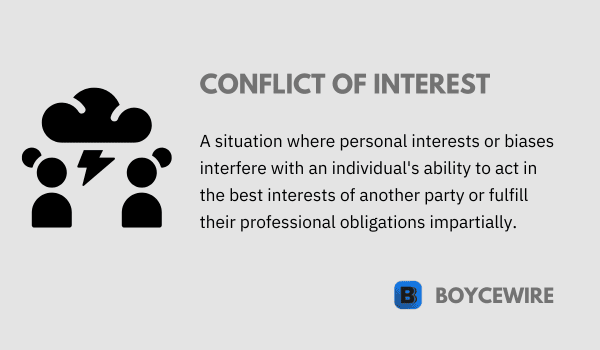Conflict of Interest: Definition, Types & Examples

What is Conflict of Interest?
Conflicts of interest arise in situations where an individual or organization may be influenced by divided loyalties. These conflicts can compromise impartiality, disrupt objectivity, and lead to potential bias or unfair advantage. A pervasive phenomenon, they occur across a broad spectrum of domains including business, politics, law, academia, healthcare, and more.
Understanding and managing conflicts of interest is of paramount importance for individuals and institutions alike. Properly handled, they safeguard the integrity of decision-making processes, uphold the principles of fairness, and contribute to the maintenance of trust in relationships. Mismanaged or ignored, they can result in ethical dilemmas, legal disputes, and severe reputational damage.
Key Points
- Conflict of interest refers to situations where personal or financial interests may interfere with professional duties or obligations.
- It can arise in various settings, including business, government, and professional relationships.
- Conflict of interest can create ethical concerns, raise questions about objectivity and fairness, and undermine trust.
Understanding Conflict of Interest
A conflict of interest arises when an individual or an entity is in a position to exploit their professional or official role for personal or financial benefit. In other words, a conflict of interest exists if the circumstances make it difficult for the individual to maintain impartiality or make a decision solely on the basis of professional responsibilities and obligations.
In a broader sense, conflicts of interest can affect not only individuals but also businesses, government bodies, non-profit organizations, and virtually any scenario where a dichotomy between personal interests and professional duties may exist. It is important to note that a conflict of interest itself isn’t necessarily unethical or illegal. It’s the actions that individuals or entities might take when a conflict exists that could be problematic.
To better recognize a conflict of interest, one should understand its three fundamental components:
- Presence of Interests: Firstly, for a conflict of interest to exist, there must be at least two interests present. One is usually a duty or responsibility towards an employer, a client, or another party. The other is typically a personal interest, which could be financial, familial, or otherwise.
- Potential for Conflict: Secondly, these interests must potentially be at odds with each other. The key word here is ‘potential’. A conflict of interest can exist even if no unethical or inappropriate actions have occurred, as long as there’s a potential for such actions.
- Decision-Making Role: Thirdly, the individual or entity in question must be in a position where they can influence decisions or outcomes.
Conflicts of interest can take on many forms and degrees of severity. They may be direct and overt, or they may be indirect and less apparent. Despite their form, their existence presents risks that should be identified, disclosed, and managed to maintain integrity and trust in professional settings.
Types of Conflicts of Interest
Conflicts of interest come in several forms. Understanding these different types can help in identifying and managing potential conflicts. Here are a few of the most common types:
- Personal Conflict of Interest: This occurs when an individual’s personal interests or relationships could potentially influence their professional responsibilities. This could involve family, friends, or personal investments. For example, if an employee has a relative who applies for a job where they will be the decision-maker, this could be seen as a personal conflict of interest.
- Professional Conflict of Interest: This arises when a professional becomes compromised because they owe a duty to more than one person or entity, and serving one interest may be adverse to the other. An example is an attorney representing two parties on the opposite sides of a legal dispute.
- Financial Conflict of Interest: This type of conflict occurs when an individual or organization can gain financially from a decision they are in a position to make. For instance, a doctor who owns a pharmaceutical company may face a financial conflict of interest if they can profit by prescribing drugs manufactured by their company to their patients.
- Organizational Conflict of Interest: This occurs when a corporation or organization provides multiple services and could potentially benefit from favoring one service over another. For instance, a consulting company might be asked to restructure a department of a corporation while simultaneously bidding for a contract to provide services with that department.
- Conflicts of Commitment: This arises when an individual’s outside activities, such as a secondary job or public service role, take time or attention away from their primary professional responsibilities.
- Intellectual Property Conflicts: These conflicts arise when a person or organization stands to benefit from the ownership or commercialization of intellectual property (like patents, copyrights, or trademarks). For example, a researcher might have a conflict of interest if they are involved in the research and development of a new product that they could potentially patent and sell.
Understanding the different types of conflicts of interest helps individuals and organizations to identify and manage them effectively. While not all conflicts can be avoided entirely, they must always be disclosed and appropriately managed to maintain trust and integrity in professional relations.
Examples of Conflicts of Interest
1. Healthcare Industry
A common conflict of interest in the healthcare industry involves a pharmaceutical company offering incentives or gifts to physicians who prescribe their medications. This presents a conflict as the physician may be swayed by personal gain rather than by what is in the best interest of their patient.
2. Politics
A politician serving in a regulatory committee may also own stock in an industry they regulate. This is a conflict of interest as the politician’s decisions could potentially impact the value of their own investments, potentially leading to decisions that are not solely based on public interest.
3. Finance and Investment
In the financial sector, a financial advisor may receive a higher commission for selling certain products. This could create a conflict of interest if they recommend products to clients based on their own potential financial gain instead of what’s most beneficial for the client.
4. Academia
An academic researcher may have a conflict of interest if they receive funding from a company that stands to benefit from the results of their research. This could potentially influence the objectivity of the research.
5. Real Estate
In real estate, a dual agency conflict can occur when the same agent represents both the buyer and the seller in a property transaction. The agent might have difficulty advocating for the best interests of both parties, as these interests may be at odds.
6. Law
An attorney represents two clients in a similar or related legal matter where the interests of the clients conflict with each other. For instance, a lawyer cannot represent both parties in a divorce as it would be nearly impossible to ensure fairness for both parties.
Avoiding Conflicts of Interest
- Full Disclosure: Transparency is crucial when it comes to conflicts of interest. All potential conflicts should be fully disclosed to relevant parties as soon as they arise. This disclosure should be made to everyone who might be affected by the conflict. It’s better to err on the side of over-disclosure in these situations.
- Establish Clear Policies: Organizations should have clear, written policies about conflicts of interest, which should be communicated and reinforced regularly. This helps everyone understand what constitutes a conflict of interest and what to do when such a situation arises.
- Education and Training: Regular training sessions can help individuals understand how to handle conflicts of interest. They can learn how to recognize potential conflicts and take appropriate steps to avoid or manage them.
- Independent Decision Making: If a conflict of interest arises, it is often helpful to involve an independent third party in the decision-making process. This can help ensure decisions are made objectively, without being influenced by the conflict.
- Avoid Dual Roles: As far as possible, individuals and organizations should avoid dual roles that can lead to conflicts of interest. This could mean not taking on two clients who are competitors or avoiding roles that involve both decision-making and oversight responsibilities.
- Recusal: If a conflict of interest arises, the individual involved may need to recuse themselves from the decision-making process. This involves stepping aside and allowing others to make decisions in their place.
By taking these steps, individuals and organizations can work to avoid conflicts of interest and manage them effectively when they do occur. It’s important to remember that the goal isn’t just to avoid wrongdoing, but also to avoid the perception of wrongdoing. Even the appearance of a conflict of interest can undermine trust and credibility.
FAQs
A conflict of interest occurs when an individual or entity has competing interests that may compromise their ability to act impartially or prioritize the best interests of others.
Examples of conflicts of interest include situations where a public official has a financial stake in a decision, a doctor accepts gifts from pharmaceutical companies that may influence prescribing behavior, or a board member of a company has personal relationships with suppliers.
Conflict of interest can undermine trust, fairness, and ethical behavior. It may lead to biased decision-making, compromised integrity, and perceptions of impropriety, ultimately impacting the credibility and reputation of individuals and organizations.
Conflict of interest can be managed through transparency, disclosure, and adherence to ethical guidelines. Organizations often implement policies and procedures to identify and address conflicts of interest, such as recusal from decision-making or establishing independent oversight.
About Paul
Paul Boyce is an economics editor with over 10 years experience in the industry. Currently working as a consultant within the financial services sector, Paul is the CEO and chief editor of BoyceWire. He has written publications for FEE, the Mises Institute, and many others.

Further Reading
 Market Share: Definition, Formula & Example - Market share refers to the percentage of a market a business owns, usually determined by its total revenue as a…
Market Share: Definition, Formula & Example - Market share refers to the percentage of a market a business owns, usually determined by its total revenue as a…  Economic Incentives: What it is, Types & Examples - In economics, incentives are what drives consumer and business behaviour.
Economic Incentives: What it is, Types & Examples - In economics, incentives are what drives consumer and business behaviour.  Foreign Direct Investment (FDI): Definition, Types, Pros & Cons - The act of a company from one nation investing in another - be it to expand production or purchase another…
Foreign Direct Investment (FDI): Definition, Types, Pros & Cons - The act of a company from one nation investing in another - be it to expand production or purchase another… 
